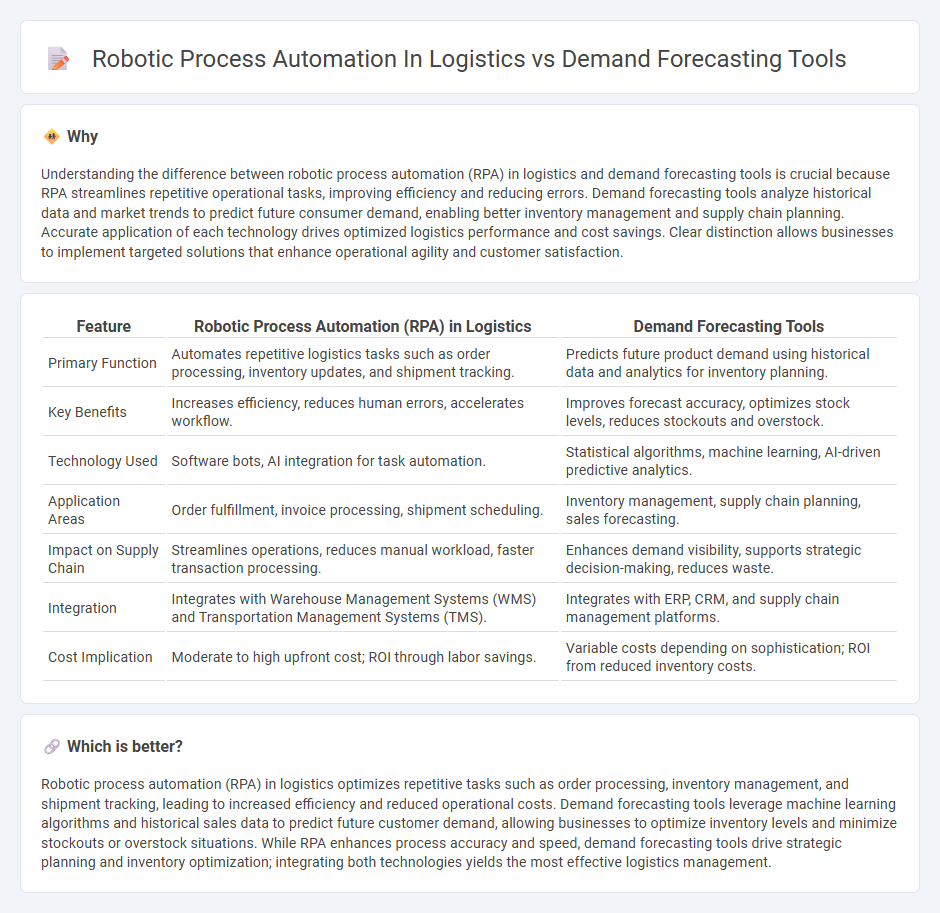
Robotic Process Automation (RPA) in logistics streamlines repetitive tasks such as order processing, inventory management, and shipment tracking, enhancing operational efficiency and reducing human error. Demand forecasting tools leverage historical data, market trends, and AI algorithms to predict future customer demand, enabling optimized inventory levels and resource allocation. Explore how integrating RPA with demand forecasting tools revolutionizes logistics for improved accuracy and cost savings.
Why it is important
Understanding the difference between robotic process automation (RPA) in logistics and demand forecasting tools is crucial because RPA streamlines repetitive operational tasks, improving efficiency and reducing errors. Demand forecasting tools analyze historical data and market trends to predict future consumer demand, enabling better inventory management and supply chain planning. Accurate application of each technology drives optimized logistics performance and cost savings. Clear distinction allows businesses to implement targeted solutions that enhance operational agility and customer satisfaction.
Comparison Table
| Feature | Robotic Process Automation (RPA) in Logistics | Demand Forecasting Tools |
|---|---|---|
| Primary Function | Automates repetitive logistics tasks such as order processing, inventory updates, and shipment tracking. | Predicts future product demand using historical data and analytics for inventory planning. |
| Key Benefits | Increases efficiency, reduces human errors, accelerates workflow. | Improves forecast accuracy, optimizes stock levels, reduces stockouts and overstock. |
| Technology Used | Software bots, AI integration for task automation. | Statistical algorithms, machine learning, AI-driven predictive analytics. |
| Application Areas | Order fulfillment, invoice processing, shipment scheduling. | Inventory management, supply chain planning, sales forecasting. |
| Impact on Supply Chain | Streamlines operations, reduces manual workload, faster transaction processing. | Enhances demand visibility, supports strategic decision-making, reduces waste. |
| Integration | Integrates with Warehouse Management Systems (WMS) and Transportation Management Systems (TMS). | Integrates with ERP, CRM, and supply chain management platforms. |
| Cost Implication | Moderate to high upfront cost; ROI through labor savings. | Variable costs depending on sophistication; ROI from reduced inventory costs. |
Which is better?
Robotic process automation (RPA) in logistics optimizes repetitive tasks such as order processing, inventory management, and shipment tracking, leading to increased efficiency and reduced operational costs. Demand forecasting tools leverage machine learning algorithms and historical sales data to predict future customer demand, allowing businesses to optimize inventory levels and minimize stockouts or overstock situations. While RPA enhances process accuracy and speed, demand forecasting tools drive strategic planning and inventory optimization; integrating both technologies yields the most effective logistics management.
Connection
Robotic process automation (RPA) streamlines repetitive logistics tasks such as order processing, inventory management, and shipment tracking, enabling faster and more accurate data flow to demand forecasting tools. Demand forecasting tools use this enhanced real-time data to predict inventory needs and optimize supply chain operations, reducing stockouts and overstock scenarios. Integration of RPA with advanced analytics platforms improves operational efficiency by ensuring timely, precise demand signals drive automated logistics processes.
Key Terms
**Demand Forecasting Tools:**
Demand forecasting tools leverage historical sales data, market trends, and advanced algorithms such as machine learning to predict future product demand with high accuracy, enabling inventory optimization and reducing stockouts in logistics. These tools integrate real-time data from multiple sources, improving supply chain responsiveness and operational efficiency. Explore how demand forecasting tools transform logistics performance and enhance decision-making processes.
Predictive Analytics
Demand forecasting tools leverage predictive analytics to analyze historical data and market trends, enabling accurate predictions of inventory needs and customer demand in logistics. Robotic process automation (RPA) streamlines repetitive tasks such as order processing and shipment tracking but relies on predefined rules rather than forecasting capabilities. Explore how combining predictive analytics with RPA can optimize logistics efficiency and decision-making.
Time Series Analysis
Time series analysis is a critical methodology in demand forecasting tools, enabling logistics companies to analyze historical data and predict future demand patterns with high accuracy. Robotic Process Automation (RPA) in logistics primarily focuses on automating repetitive tasks such as data entry and order processing rather than performing complex statistical forecasting. Explore how integrating time series analysis with RPA can optimize logistics operations and improve demand prediction accuracy.
Source and External Links
Demand Planning vs. Forecasting: Key Methods, Tools and ... - Flieber - Demand forecasting tools include spreadsheet tools (Excel, Google Sheets), Advanced Planning Systems (APS), machine learning-based tools that use real-time and historical data for accuracy, and Enterprise Resource Planning (ERP) systems for comprehensive demand and inventory management.
Top 13 Inventory Forecasting Software for 2024 - Akkio - Popular demand forecasting tools include Oracle Retail Demand Forecasting Cloud Service with advanced analytics, Netstock for ERP integration and real-time data, Management One's Retail Orbit focusing on retail demand sensing, and Restock Pro designed for Amazon FBA sellers to optimize inventory.
Best 5 Demand Forecasting Methods for 2025 | ThroughPut AI - Key demand forecasting methods are historical data analysis, market research, AI-driven demand sensing to capture real-time demand changes, predictive sales analytics with machine learning, and external macro forecasting analyzing broader economic trends.
 dowidth.com
dowidth.com